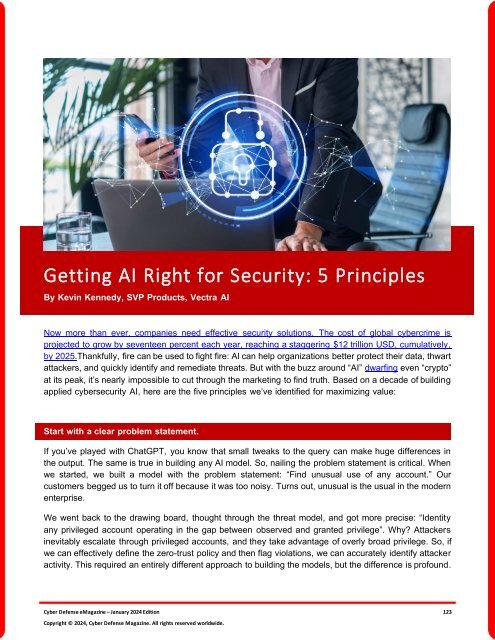The Cyber Defense eMagazine January Edition for 2024
Cyber Defense eMagazine January Edition for 2024 #CDM #CYBERDEFENSEMAG @CyberDefenseMag by @Miliefsky a world-renowned cyber security expert and the Publisher of Cyber Defense Magazine as part of the Cyber Defense Media Group as well as Yan Ross, Editor-in-Chief and many more writers, partners and supporters who make this an awesome publication! 201 page January Edition fully packed with some of our best content. Thank you all and to our readers! OSINT ROCKS! #CDM #CDMG #OSINT #CYBERSECURITY #INFOSEC #BEST #PRACTICES #TIPS #TECHNIQUES
Cyber Defense eMagazine January Edition for 2024 #CDM #CYBERDEFENSEMAG @CyberDefenseMag by @Miliefsky a world-renowned cyber security expert and the Publisher of Cyber Defense Magazine as part of the Cyber Defense Media Group as well as Yan Ross, Editor-in-Chief and many more writers, partners and supporters who make this an awesome publication! 201 page January Edition fully packed with some of our best content. Thank you all and to our readers! OSINT ROCKS! #CDM #CDMG #OSINT #CYBERSECURITY #INFOSEC #BEST #PRACTICES #TIPS #TECHNIQUES
You also want an ePaper? Increase the reach of your titles
YUMPU automatically turns print PDFs into web optimized ePapers that Google loves.
Getting AI Right <strong>for</strong> Security: 5 Principles<br />
By Kevin Kennedy, SVP Products, Vectra AI<br />
Now more than ever, companies need effective security solutions. <strong>The</strong> cost of global cybercrime is<br />
projected to grow by seventeen percent each year, reaching a staggering $12 trillion USD, cumulatively,<br />
by 2025.Thankfully, fire can be used to fight fire: AI can help organizations better protect their data, thwart<br />
attackers, and quickly identify and remediate threats. But with the buzz around “AI” dwarfing even “crypto”<br />
at its peak, it’s nearly impossible to cut through the marketing to find truth. Based on a decade of building<br />
applied cybersecurity AI, here are the five principles we’ve identified <strong>for</strong> maximizing value:<br />
Start with a clear problem statement.<br />
If you’ve played with ChatGPT, you know that small tweaks to the query can make huge differences in<br />
the output. <strong>The</strong> same is true in building any AI model. So, nailing the problem statement is critical. When<br />
we started, we built a model with the problem statement: “Find unusual use of any account.” Our<br />
customers begged us to turn it off because it was too noisy. Turns out, unusual is the usual in the modern<br />
enterprise.<br />
We went back to the drawing board, thought through the threat model, and got more precise: “Identity<br />
any privileged account operating in the gap between observed and granted privilege”. Why? Attackers<br />
inevitably escalate through privileged accounts, and they take advantage of overly broad privilege. So, if<br />
we can effectively define the zero-trust policy and then flag violations, we can accurately identify attacker<br />
activity. This required an entirely different approach to building the models, but the difference is profound.<br />
<strong>Cyber</strong> <strong>Defense</strong> <strong>eMagazine</strong> – <strong>January</strong> <strong>2024</strong> <strong>Edition</strong> 123<br />
Copyright © <strong>2024</strong>, <strong>Cyber</strong> <strong>Defense</strong> Magazine. All rights reserved worldwide.

















